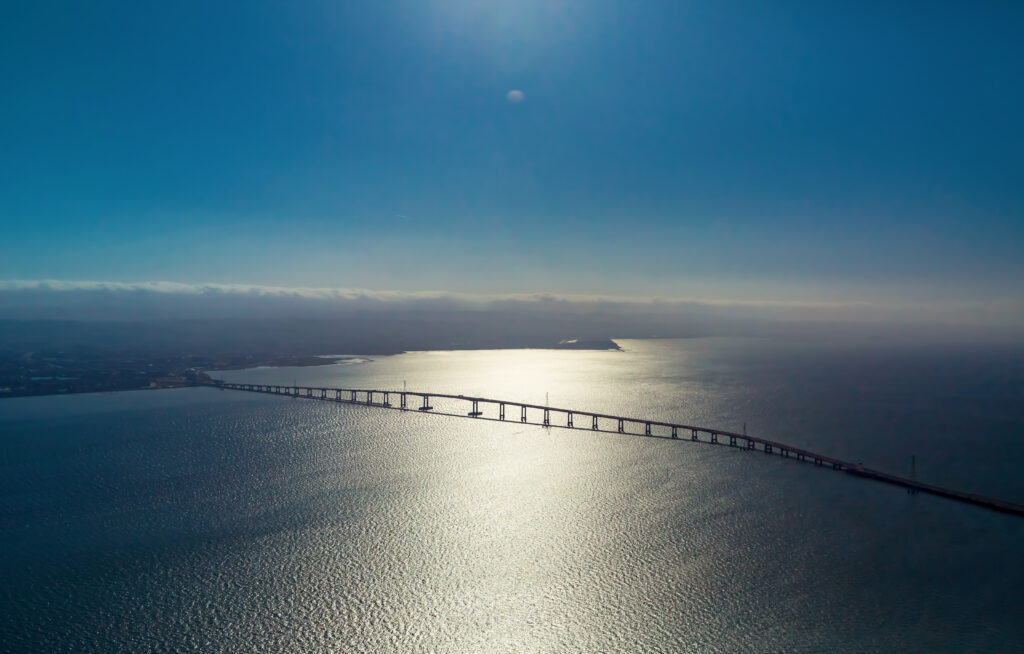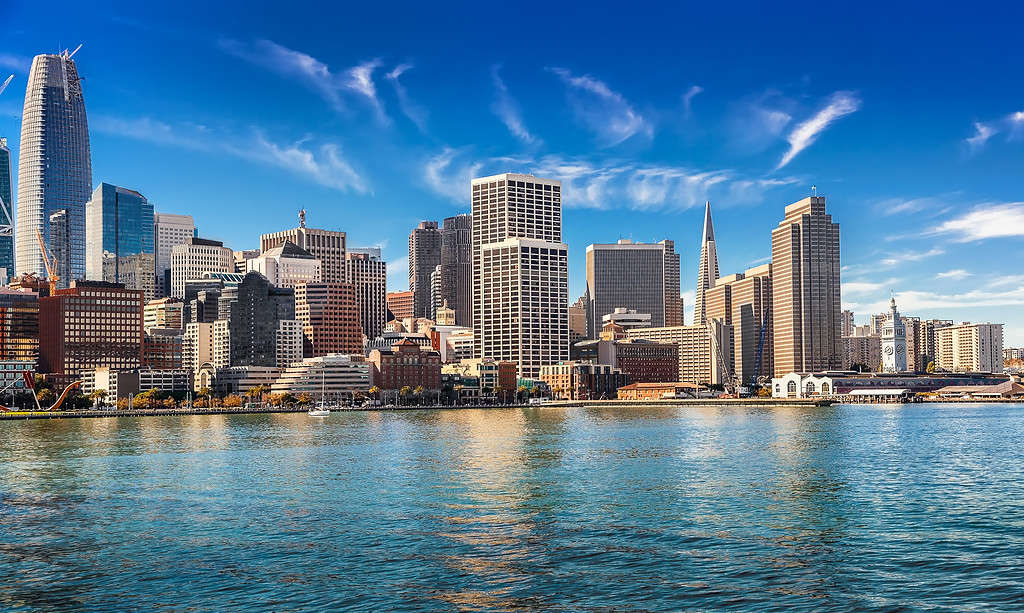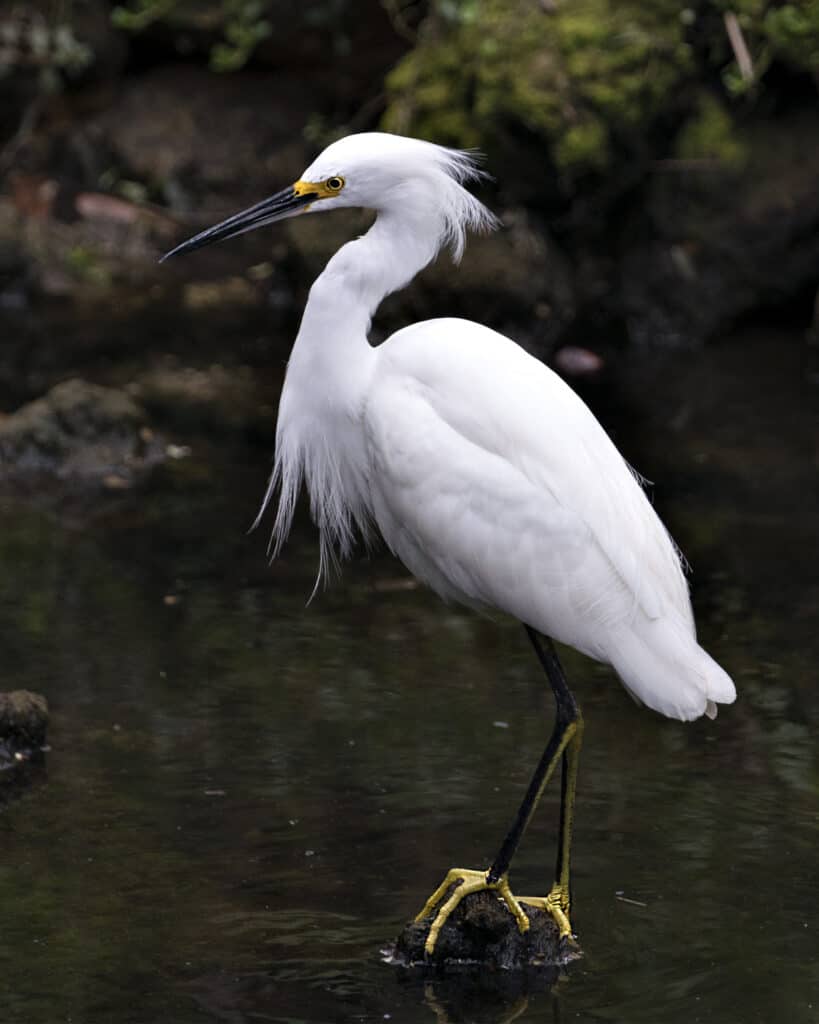The San Francisco Bay lies in northern California, stretching for miles and draining 40 percent of California’s water into the Pacific Ocean. The bay is an important ecosystem for many wetlands creatures, along with housing mighty cities such as San Francisco and Oakland on its shores. The bay has been an important part of human history for a long time, and we’re going to look to the very bottom of it. Let’s find out how deep San Francisco Bay is, and a bit about the kind of life it houses.
Depth of the Bay

At its deepest point, San Francisco Bay is 372 feet deep.
©iStock.com/Melpomenem
At its deepest point, San Francisco Bay is 372 feet deep, but the entirety of the bay is actually quite shallow. Its depths average 12-15 feet, with 85 percent of the bay’s area being less than 30 feet deep. The bay possesses characteristics of a drowned valley – a valley flooded by the sea. Deep channels cut through the bottom of the bay, markers of the streams that flowed there before the valley flooded. Tidal marshes define many of the bay’s shores, providing vast estuary systems that make perfect homes for several bird species.
The San Francisco Bay is the largest Pacific estuary in the Americas, spanning over 1,600 square miles in the bay alone. The bay watershed encompasses over 4,600 square miles. Water salinity is measured by a metric called PSU (Practical Salinity Unit). This measures salt concentration in seawater specifically and is based on a measurement of the properties of seawater conductivity. The salinity of the bay ranges from 2-25 PSU, in comparison to an average of 34.7 PSU in the ocean.
Formation of the Bay
The San Francisco Bay is a flooded river valley that formed as a bay during the end of the last Ice Age. Rolling grasslands used to thrive where the water flows now, and this relatively new formation of land and water has only existed for around 10,000 years. Melt from the Sierra Nevada glaciers flowed down into the ocean, causing sea levels to rise. These rising sea levels caused seawater to begin flowing into the valley. Fresh and sea water converge to create a mixed and brackish environment that is rich with estuary waters.
The waters rose slowly over hundreds of years. At a rate of 1 inch per year, it took several generations for the waters to reach their current levels. Sediment began to form around the edges of this new bay, which created marshy environments rich in nutrients for local fauna and flora.
Cities Along the Water

The shores of San Francisco Bay house several different cities with varying populations.
©iStock.com/NAN104
The shores of San Francisco Bay house several different cities with varying populations. We’ve included a table of some of the cities that rest on the shores of the Bay Area. Our population data is based on the results of the 2021 census.
| City | Population | Popular Feature |
|---|---|---|
| San Francisco | 815,201 | Golden Gate Bridge |
| Oakland | 433,823 | Jack London Square |
| San Jose | 983,489 | Capital of Silicon Valley |
| Fremont | 227,514 | Mission San Jose |
| Palo Alto | 66,680 | Birthplace of Silicon Valley |
The Bay Area is one of the most populated portions of California. San Jose is the third largest city by population in California and the tenth largest in the entirety of the United States. San Francisco is one of the most cosmopolitan cities in the United States and also the 18th largest city. Oakland is the 45th largest city in the nation. Fremont ranks 103rd for size, almost breaking the top 100 largest cities in the nation. That means that most of the Bay Area makes the list of the most populated cities in the nation. That makes sense – California is the most populated state in the United States. The Bay Area in total encompasses almost 8 million people!
Where is the San Francisco Bay Located on a Map?
San Francisco Bay lies in the heart of the city of San Francisco, California on the west coast of the United States. The famous Golden Gate Bridge crosses the bay, connecting the city to Marin County. Altogether, the bay includes the counties of Marin, Sonoma, Napa, Solano, San Francisco, San Mateo, Contra Costa, Alameda, and Santa Clara.
A Short History of Humans in the Bay
Humans have lived in the Bay Area since 8-10,000 BCE. The shell mounds in Coyote Hills are the oldest evidence of human civilization in the area. Jumping forward to the 1700s, the Ohlone inhabited the Bay Area until and after the arrival of Spanish colonists.
In 1769, Spanish colonists discovered the Bay, which was the beginning of modern civilization in the area. When Spanish explorer Gaspar de Portola first saw the vast waters and lush geography of the area, he found it to be perfect for settlement. The result of this was the first formations of the cities that would follow. Control of the area was shaky until 1846 when the United States seized it from the Mexican government.
Soon after, the Gold Rush brought new settlers to the area. The Bay became a major port of entry for gold rushers seeking their fortunes. San Francisco was growing and booming, but it faced new challenges at the turn of the 20th century. In 1906, a massive earthquake leveled the city, leaving residents to rebuild the lives they had been parted from by the disaster. After rebuilding, the growth of the area began to boom again, and the Bay Area became a hub for artistic, technological, political, and social movements.
Now, the Bay Area is still a hub for commerce, drawing several Fortune 500 companies. Now the area boasts the 3rd-largest collection of Fortune 500’s and generates over 700 billion dollars of gross domestic product per year. It is the home to Silicon Valley, one of the most concentrated and advanced technological hubs in the world.
Wildlife in the Bay

The snowy egret is just one of many birds you can observe living in the Bay Area.
©iStock.com/Rejean Bedard
Despite large human populations, there is still plenty of wildlife in the Bay Area. More than 500 species of animals thrive in the area, including California sea lions, harbor seals, and brown pelicans. Animals like this are amazing to get a glimpse of, and some of them have special features specific to the area they live in. For example, the Pacific harbor seal (Phoca vitulina) is the only marine mammal that inhabits the Bay Area year-round.
Since there is so much wildlife to be observed and appreciated, we’ve included a short list of each different type of animal species that can be found in the area. We’ll also follow up in the next section about the best places to see a lot of this wildlife.
Mammals
- Bobcat (Lynx rufus)
- Northern elephant seal (Mirounga angustirostris)
- Striped skunk (Mephitis mephitis)
- Humpback whale (Megaptera novaeangliae)
- Red fox (Vulpes vulpes)
Fish
- Striped bass (Morone saxatilis)
- Northern Clingfish (Gobiesox maeandricus)
- Monkeyface prickleback (Cebidichthys violaceus)
- Common mola (Mola mola)
- White sturgeon (Acipenser transmontanus)
Birds
- Snowy egret (Egretta thula)
- Double-crested cormorant (Nannopterum auritum)
- American coot (Fulica americana)
- Black-crowned night heron (Nycticorax nycticorax)
- Ruddy duck (Oxyura jamaicensis)
Insects
- Chalcedon checkerspot (Euphydryas chalcedona)
- Firecracker skimmer (Libellula saturata)
- European mantis or (Mantis religiosa)
- Bronze beetle (Chrysolina bankii)
- Valley carpenter bee (Xylocopa sonorina)
Best Places to Observe Wildlife
The Bay Area is rich with wildlife viewing opportunities. The packed cosmopolitan areas may seem like all concrete jungles and highway traffic, but care has been taken to try to preserve the natural habitats of several animal species. The Golden Gate National Recreation Area is a great example of this. The park contains wetlands, grasslands, scrublands, and forests. This creates an area of diversity for plant and animal species.
The Bay Area Water Trail is also a great place to see wildlife. The water trail takes you through some of the massive estuary, which is the winter resting place of over 1,000,000 birds. This is also a great place to see California sea lions and harbor seals, especially in their mating seasons.
Near San Jose, Steven’s Creek County Park is a smaller but still wild and beautiful area for hikes, wildlife observation, and horseback riding.
As always, we remind you to take care while viewing wildlife. Despite taking good care to try to build and preserve natural habitats, we still have the largest impact on natural life. We cannot truly appreciate the importance of this nature without gaining a scope of perspective on it, and preserves and parks highlighting this nature are fantastic resources for gaining appreciation and understanding. They need your help to be successful. Keep a safe distance from all wild animals, pack out the trash you bring in, and use quiet voices when exploring. This helps ensure a legacy of animal conservation and enables the successful repopulation of endangered species.
The photo featured at the top of this post is © Bill Florence/Shutterstock.com
Thank you for reading! Have some feedback for us? Contact the AZ Animals editorial team.







